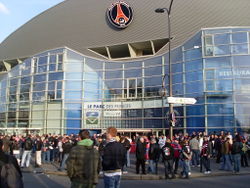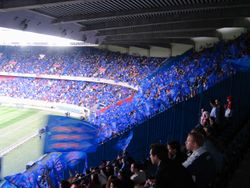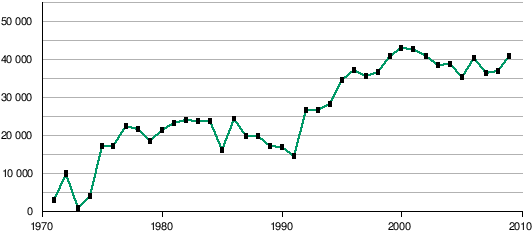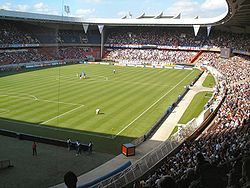Parc des Princes
| Parc des Princes | |
|---|---|
| Le Parc | |
|
|
|
| Full name | Parc des Princes |
| Location | Paris, France |
| Built | 1897 |
| Opened | 18 July 1897 |
| Renovated | 1932, 1972 |
| Owner | City of Paris |
| Operator | SESE |
| Surface | Grass |
| Construction cost | ₣ 90m / € 13m |
| Architect | Roger Taillibert |
| Capacity | 48,713 |
| Field dimensions | 252m x 191m |
| Tenants | |
| Paris Saint-Germain F.C. (1974–present) | |
The Parc des Princes (French pronunciation: [paʁk de pʁɛ̃s], Princes' Park) is a stadium located in the 16th arrondissement of Paris, France, currently the home of football team Paris Saint-Germain, with a seating capacity of 48,712.[1] Originally a velodrome, it was the finish of the Tour de France from the first event in 1903 until the track's demolition in the late 1960's. It was also previously the national stadium until the Stade de France was built for the 1998 FIFA World Cup. The Parc des Princes stadium and grounds are owned by the City of Paris. The name Parc des Princes was given to the surrounding area during the 18th century, when it was a forest used by the royal family for hunting.
Officially opened on 4 June 1972, the Parc des Princes has always been somewhat ahead of its time. As a result, while the rest of France launches itself into a programme of stadium renovations, the ground based in Porte de Saint-Cloud still stands up well to current standards. It was conceived by architect Roger Taillibert and is built from concrete. It is capable of seating 48,712. Its average attendance for this term has been 43,000. It also hosts concerts on various occasions. The stadium is served by two stations on the Paris Métro: Porte de Saint-Cloud and Porte d'Auteuil.
Contents |
Velodrome
In one corner of the 19th century Parc des Princes was a laboratory. It was demolished in 1897 and the site became a sports stadium. It was so quickly and badly built that spectators were denied access to the stands when it opened on July 18. There were fears that the stands would give way under the weight of spectators.
The track, managed by Henri Desgrange, who in 1903 founded the Tour de France, was 666 metres round, egg-shaped and almost without banking. The cycle track was the main feature but the size of the inner field meant other sports could be held there and, as Paris's main sports stadium, it accommodated the Olympic Games in 1924. By then the seating had expanded to 20,000 places. Desgrange and his successor, Jacques Goddet, then expanded capacity to 40,000. In fact there were 46,000 for the opening and the two were disciplined by the city authorities for overcrowding. At the same time, the track was reduced to 454 metres, given parallel straights and steeper bankings.[2]
The second Parc des Princes hosted the final of the inaugural Rugby League World Cup in 1954, when Great Britain defeated France 16–12.
The last man to win a race on the track was Raymond Poulidor, when he won the last stage of the 1967 Tour de France. Roger Pingeon, the overall Tour winner, accepted his yellow jersey in a stadium in which demolition had already started.
Demolition
The cycle track was demolished to make room for a bypass, the Périphérique, to be built around Paris. Keeping the road to a straight line took it under one end of the track. Two of the Parc's four stands were demolished, and the rest stayed up for another two years before neglect meant they too had to come down.
Jacques Goddet, who had taken ownership of the track on the death of Henri Desgrange, fought the demolition order. He said:
| “ | That the administration of the city, with an especially motivated sports advisor, should want to interrupt the activities of the company running the Parc – my company – demands explanations. We had been model partners going right back to the previous century, having the most courteous, the most straightforward dealings with the administration of the city of Paris, which owned our land from its beginnings. We were its tenants and therefore we had a lease. It had all the clauses that any lease would have, right down to rights to raise the rent, terms for extension of the period of lease… As tenants, paying rent, we were therefore entitled to our rights, which were that when the time came to eject us, there was a duty, without discussion, to pay us the costs of the ending of the lease. Those would have been considerable sums, because our little Parc, its buildings and installations, just 32 years old, and its pretty pink track were in excellent state and produced a good income... We found out that what the city of Paris had told us was a lease – something that nobody denied – wasn't one! What had been called a lease, treated as a lease, was just an error of description on the part of the city of Paris. Since 1898! And we who thought we were tenants, with all the rights of tenants, rights that until then had always been respected, suddenly found that under the law we were common concessionaires, people who could be shown the door without any legal discussion and without any damages. | ” |
|
—Jacques Goddet |
||
A lawyer had found that the hiring agreement in the 19th century included a clause that children of a local school were allowed free use of the stadium on Thursday afternoons. The city of Paris claimed no tenancy agreement would include such a condition. A tenant had exclusive use of what he rented. Therefore Goddet had just a concession to use the land and could be evicted without compensation.
Goddet took the argument to appeal but failed. The velodrome became rubble to form the foundations of a soccer stadium. The track's shareholders received nothing in damages.[2]
Football stadium

The current Parc des Princes, designed by architect Roger Taillibert and built by Bouygues, was opened in June 1972 and is a true football and rugby stadium with no track around the pitch. It is currently the home of football team Paris Saint-Germain while the rugby union club Stade Français competes across the road at the much smaller Stade Jean Bouin, but sometimes uses the Parc des Princes (although in recent years the club has used Stade de France as its secondary home).
There have been two previous stadia on the site, which opened in 1897 and 1932, respectively. Both were essentially velodromes, and for many years (1904–1967) the stadium was the traditional finishing point for the Tour de France cycling race. Taillibert's all-seater design has proven in retrospect to be well ahead of its time, requiring only cosmetic improvements to meet vastly increased comfort and safety regulations through the 1990s and early 2000s.
On 10 November 1973, Paris SG held their first match at the Parc des Princes during a Division 2 match against Red Star Saint-Ouen. The capital club won the match 3–1. The following year, PSG left the Stade Georges Lefèvre and became Le Parc's sole tenant. The club had to play a few games at the Stade Olympique Yves-du-Manoir in Colombes (once in 1974–75)[3] and the Stade de Paris (once in 1977–1978 and twice in 1978–79) because Le Parc was unavailable due to work on the lawn.

Racing Club de Paris played their home matches at the Parc des Princes from 1984 to 1990. In 1992, after the club was bought by Canal +, the TV channel took control of the SESE, company which holded the concession to the Parc des Princes since June 1988. The club now paid their rent to Canal +.[4] On 28 June 1999, the City of Paris extended the concession from the Parc des Princes for another 15 years. On 18 February 2002, PSG fully appropriates the stadium and the headquarters of the club are moved to a new building. After the club was sold by Canal + to a consortium comprising American investment company Colony Capital, French investment company, Butler Capital Partners, and American investment bank, Morgan Stanley on 11 April 2006, the City of Paris extended the concession until 2014.
Having acquired PSG in 2006, the international real estate investment firm Colony Capital announced a plan to upgrade the Parc des Princes, including the building of luxury amenities and a capacity expansion to 54,000. However, the dismal performance of the club since the takeover have caused this plan to be put on hold. Whether the proposed expansion has the approval of the Paris city council is unclear as of late 2007.
On 16 September 2009, the mayor of Paris, Bertrand Delanoë, made official in a communiqué the will of the city to organise the UEFA Euro 2016 in Paris Saint-Germain's stadium, the Parc des Princes, which will be renovated. Delanoë has committed himself to "submit the Council of Paris (the municipal assembly), before new years eve, to a deliberation that allows to carry out the modernisation of the Parc des Princes, following the UEFA rules, before 2016". The mayor "reaffirms his total determination to make out of the renovated Parc des Princes an advantage for France's candidature" in order to organize the competition.[5]
Since the construction of the the Stade de France in 1998, that stadium has not enjoyed a regular tenant and there have been repeated attempts to convince a professional football or rugby team to move to there. Although occupancy was offered to PSG, the capital club remained at Parc des Princes under pressure from Canal +, its former parent company, and the Paris city government.
Kop of Boulogne
The Kop of Boulogne (KOB) is an area in the Parc des Princes which houses supporters groups associated with the French football club Paris Saint-Germain. It is known as the "most notorious stand in French football" due to its links with violence and far-right political groups and is a symbol for football hooliganism and political extremism within French culture.[6]
Attendance
The highest average home attendance of the club was registered during the 1999–2000 season with 43,185 spectators per game.[7] 49,575 spectators is the attendance record and was registered in the UEFA Cup quarter-finals match between PSG and SV Waterschei Thor on 2 March 1983. The club's average home gate for the 2008–09 season was 40,902, the second highest in the Ligue 1.[8]

Memorable matches
The modern Parc des Princes hosted one of France's greatest football achievements, the 2–0 victory over Spain in the 1984 European Championship final. It was also the scene of one of French football's most spectacular disasters on November 17, 1993, when Les Bleus were beaten 1–2 by Bulgaria in the last minute of play and thus failed to qualify for the 1994 FIFA World Cup in the United States. At the club level, the Parc des Princes has been the scene of some of Paris Saint-Germain's most memorable European games, in particular a 4–1 victory over Real Madrid in the UEFA Cup quarter-final in 1993 in which PSG scored the crucial last goal on the very last play of the game.
Les Bleus have returned to the Parc des Princes only once since the opening of the Stade de France in 1998. On September 12, 2007, they were defeated 0–1 by Scotland in a Euro 2008 qualifier.
Parc des Princes also hosted various 2007 Rugby World Cup matches including the Argentina-Ireland showdown.
See also
- Musée national du Sport
References
- ↑ "Le Parc des Princes". LeParcdesPrinces.fr. http://www.leparcdesprinces.fr/Home.html. Retrieved 19 October 2009.
- ↑ 2.0 2.1 Goddet, Jacques: L'Équipée Belle, Robert Laffont, Paris, 1991
- ↑ France Football, N°1506 of 11 February 1975, p.8-9 : PSG-Lyon on 9 February 1975.
- ↑ "Le Parc des Princes passera-t-il le Mondial ?". L'Humanité. 31 October 1997. http://www.humanite.presse.fr/journal/1997-10-31/1997-10-31-790721. Retrieved 29 October 2009.
- ↑ "París anuncia su voluntad de organizar la Eurocopa de 2016". Agence France-Presse. 16 September 2009. http://www.google.com/hostednews/afp/article/ALeqM5hp4TrP-pmZBdLVWoK19IMtv_Go5w. Retrieved 21 September 2009.
- ↑ "Young Parisians". When Saturday Comes. January 2007. http://www.wsc.co.uk/content/view/635/29/. Retrieved 14 April 2010.
- ↑ 7.0 7.1 "Historique des affluences de spectateurs de Paris-SG". Stades-Spectateurs.com. http://www.stades-spectateurs.com/historique-affluences-spectateurs.php?club=Paris-SG. Retrieved 22 October 2009.
- ↑ "Attendances 2008/09". Ligue 1. http://www.ligue1.com/ligue1/stat/affluence_club.asp?saison=2008/2009. Retrieved 28 September 2009.
External links
- Official Websites
- (French) (English) Official Stadium Website
- (French) (English) PSG Website
- (French) (English) Paris Saint-Germain F.C. at the Ligue 1 Official Website
- (French) (English) Paris Saint-Germain F.C. at the UEFA Official Website
- News Sites
- (French) Paris Saint-Germain News from Le Parisien
- (French) Paris Saint-Germain News from L'Equipe
- (English) Paris Saint-Germain News from Sky Sports
|
||||||||||||||||||||||||||||||||
|
|||||||||||||||||||||||||||||
|
|||||
|
|||||
|
|||||
|
|||||
| Navigation Boxes | |||||||||||||||||||||||||||
|---|---|---|---|---|---|---|---|---|---|---|---|---|---|---|---|---|---|---|---|---|---|---|---|---|---|---|---|
|
